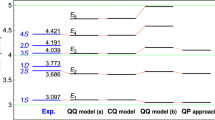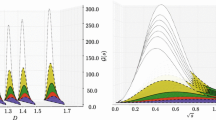Abstract
We suggest the description of the dressed fermion propagator with parity non-conservation in the form with separated positive and negative energy poles. We found general form of the γ-matrix off-shell projectors and corresponding resonance factors. The parity violation leads to deviation of resonance factors from the naive Breit–Wigner form and to appearance of non-trivial spin corrections. However, for top quark with SM vertex the resonance factor returns to the standard one due to Γ/m≪1.
Similar content being viewed by others
Notes
From our point of view, this representation for dressed fermion propagator is physically justified. If we are concerned with baryon resonance production, πN→N′→πN, then coefficients at Λ ± in (5) appear in different partial waves and it makes no sense to join them together. Besides, it has long been known that proper variable for fermions is W, not s, see e.g. MacDowell symmetry [16], when W→−W.
In fact we used for our purposes the so called spectral representation of operator (see, e.g. textbook [17]). In quantum-mechanical notations it has the form:
$$ \hat{A}=\sum_{i}\lambda_{i} \varPi_{i}=\sum_{i}\lambda_{i} |i \rangle \langle i|, $$where |i〉 are eigenvectors
$$ \hat{A}|i \rangle =\lambda_{i}|i \rangle , $$and Π i =|i〉〈i| are corresponding projectors.
We wrote λ i in a form respecting the symmetry property λ 2(W)=λ 1(−W), valid for bare values.
We want to pay attention on appearance of factor K in these formulas, it arises because λ 1 and λ 2 are normalized at different points: W=m and W=−m correspondingly. Note that the natural variable for fermions is just W, but not W 2, it is well known, e.g. in πN scattering. This fact leads to some difference in resonance denominators of fermion and boson propagators, noted in [20].
We prefer to use the form (51) instead of chiral projectors a ±=(1±γ 5)/2 to have more simple intermediate expressions.
The requirement \(\lambda_{1}^{\text {r}}(W_{1})=0\) allows unambiguously to fix x.
References
W. Wagner, Rep. Prog. Phys. 68, 2409 (2005)
A. Quadt, Eur. Phys. J. C 48, 835 (2006)
J.R. Incandela, A. Quadt, W. Wagner, D. Wicke, Prog. Part. Nucl. Phys. 63, 239 (2009)
V. Khachatryan et al., Phys. Lett. B 695, 424 (2011)
S. Chatrchyan et al., J. High Energy Phys. 1107, 049 (2011)
G. Aad et al., Eur. Phys. J. C 71, 1577 (2011)
G. Aad et al., Phys. Lett. B 707, 459 (2012)
W. Bernreuther, J. Phys. G 35, 083001 (2008)
A.E. Kaloshin, V.P. Lomov, Phys. At. Nucl. 69, 541 (2006)
B.A. Kniehl, A. Sirlin, Phys. Rev. D 77, 116012 (2008)
A. Sirlin, Phys. Rev. Lett. 67, 2127 (1991)
A. Sirlin, Phys. Lett. B 267, 240 (1991)
M. Passera, A. Sirlin, Phys. Rev. D 58, 113010 (1998)
P. Gambino, P.A. Grassi, Phys. Rev. D 62, 076002 (2000)
M. Nekrasov, Phys. Lett. B 531, 225 (2002)
S.W. MacDowell, Phys. Rev. 116, 774 (1959)
A. Messiah, Quantum Mechanics, vol. 1 (North-Holland, Amsterdam, 1961)
A. Denner, Nucl. Phys. B 347, 184 (1990)
K.I. Aoki, Z. Hioki, M. Konuma, R. Kawabe, T. Muta, Prog. Theor. Phys. Suppl. 73, 1 (1982)
M.O. Gonchar, A.E. Kaloshin, V.P. Lomov, Mod. Phys. Lett. A 22, 2511 (2007)
A. Denner, Fortschr. Phys. 41, 307 (1993)
D.Y. Bardin, G. Passarino, The Standard Model in the Making: Precision Study of the Electroweak Interactions. International Series of Monographs on Physics (Clarendon Press, Oxford, 1999)
D. Espriu, J. Manzano, P. Talavera, Phys. Rev. D 66, 076002 (2002)
W. Grimus, P. Stockinger, Phys. Rev. D 57, 1762 (1998)
W. Grimus, P. Stockinger, S. Mohanty, Phys. Rev. D 59, 013011 (1999)
Acknowledgements
We thank Slava Lee for participation at initial stage of the work and V.A. Naumov for discussion and valuable advice.
Author information
Authors and Affiliations
Corresponding author
Rights and permissions
About this article
Cite this article
Kaloshin, A.E., Lomov, V.P. Top quark as a resonance. Eur. Phys. J. C 72, 2094 (2012). https://doi.org/10.1140/epjc/s10052-012-2094-y
Received:
Revised:
Published:
DOI: https://doi.org/10.1140/epjc/s10052-012-2094-y




